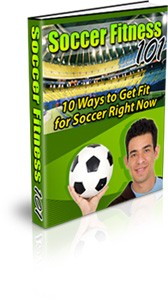 License Type: Private Label Rights
License Type: Private Label Rights  File Size: 11,861 KB
File Size: 11,861 KB File Type: ZIP
File Type: ZIP
 SKU: 792
SKU: 792  Shipping: Online Download
Shipping: Online Download
Ebook Sample Content Preview:
As we mentioned before, using your hands is completely off limits when you’re playing soccer; however, that is quite literally the only part of your body that you are not allowed to use. With that in mind we’ll give you a brief introduction to the use of your chest and head when you are playing the game.
Using your chest to block the ball is a simple matter. As you might imagine, you use your chest to block balls that are coming at you at too great a height to get a hold of with your knees but not quite high enough to hit with your head, and it is a great way to divert what would otherwise be a penalty for touching the ball with your hands (every once in a while the ball comes at you at just such an angle that you virtually have no choice). Simply spread your arms wide to the sides in the same manner as you would if you were being searched by a police officer to ensure that they are safely out of the way and center your chest around the ball.
It is vitally important that when you are taking a ball to the chest you place it appropriately. The proper place to stop a soccer ball with your chest is smack dab in the middle of the breastbone. Ladies, this is approximately where the uppermost portion of your cleavage is, and if you want to prevent a great deal of discomfort you’ll be sure that you place the ball appropriately. This is equally important for both sexes, however; at the bottom of your breast bone you have a tiny extension of bone known as the xiphoid process, and although this bone has generally hardened by the time you reach adulthood it is still far more easily damaged that the rest of your sternum. A well placed ball or a poorly placed kick could result in this bone fracturing off and puncturing a lung, so it is essential that you ensure this is not the part of your body you are willingly offering up for target practice.
A chest block is precisely what it sounds like-a block. Its entire purpose is to stop the ball’s forward motion and restore it to your control (ideally the ball will drop down between your feet after it strikes your chest). A head block, on the other hand, serves to not only stop the forward motion of the ball but to send it on another trajectory as well. Ideally you would use your head to stop a ball that was flying through the air at a level even to or higher than your forehead-attempting to squat down to get your head under a ball is possible, but generally not very comfortable.
As with the chest block it is very important that you ensure that the ball connects with your head in just the right point. You want to hit it using the broad portion of your forehead between your eyes; any higher and you will not be able to use your neck muscles to connect with the ball and change its trajectory (the ball will simply bounce off the top of your head), any lower and you will find yourself sporting a bloody and possibly broken bone for the remainder of the day. The trick is to draw your neck back just slightly, then get your head moving forward before it meets the ball so that you can use the your forehead and the ball’s own momentum to change its course.








